The global IBC rental business market is valued at USD 3.2 billion in 2025 and is set to reach USD 7.4 billion by 2035, recording an absolute increase of USD 4.2 billion over the forecast period. This translates into a total growth of 131.3%, with the market forecast to expand at a CAGR of 8.7% between 2025 and 2035. The market size is expected to grow by approximately 2.3X during the same period, supported by increasing demand for cost-effective bulk liquid transport solutions, growing chemical industry expansion, rising adoption of circular economy principles, and expanding requirements for flexible storage solutions across pharmaceutical, food processing, and agricultural sectors.
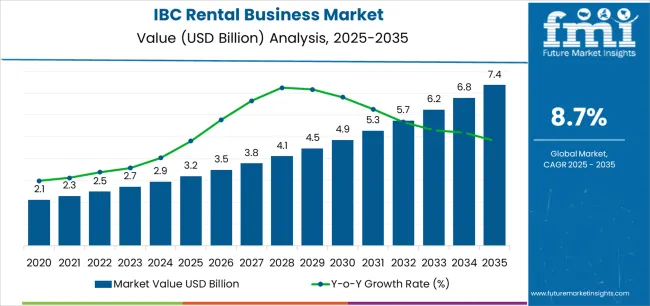
Between 2025 and 2030, the IBC rental business market is projected to expand from USD 3.2 billion to USD 4.9 billion, resulting in a value increase of USD 1.7 billion, which represents 40.5% of the total forecast growth for the decade. This phase of development will be shaped by increasing demand for flexible logistics solutions, rising chemical production requiring specialized storage, and growing availability of digital tracking systems across industrial operations and specialty chemical applications.
Between 2030 and 2035, the market is forecast to grow from USD 4.9 billion to USD 7.4 billion, adding another USD 2.5 billion, which constitutes 59.5% of the ten-year expansion. This period is expected to be characterized by the advancement of smart IBC technologies, the integration of IoT monitoring systems for real-time tracking, and the development of specialized rental programs across diverse industrial categories. The growing emphasis on asset optimization and operational efficiency will drive demand for advanced IBC rental services with enhanced tracking capabilities, improved cleaning processes, and superior logistics coordination.
Between 2020 and 2024, the IBC rental business market experienced robust growth, driven by increasing industrial demand for flexible container solutions and growing recognition of rental models' effectiveness in supporting cost-efficient operations across manufacturing and processing sectors. The market developed as businesses recognized the potential for IBC rental services to deliver capital efficiency while meeting modern requirements for regulatory compliance and operational flexibility patterns. Technological advancement in container tracking and fleet management practices began emphasizing the critical importance of maintaining asset visibility while enhancing logistics coordination and improving customer service delivery.
| Metric | Value |
|---|---|
| Estimated Market Value (2025E) | USD 3.2 Billion |
| Forecast Market Value (2035F) | USD 7.4 Billion |
| Forecast CAGR (2025-2035) | 8.7% |
The chemical storage and transportation market is the largest contributor, accounting for approximately 35-40%, as IBCs are ideal for transporting hazardous and non-hazardous liquids in bulk, providing safety and regulatory compliance. The food and beverage market contributes around 25-30%, as IBCs are used for transporting bulk ingredients, beverages, and additives, offering cost-effective and hygienic solutions for the food industry. The pharmaceutical and healthcare market adds approximately 15-20%, with IBCs essential for transporting sensitive materials like active pharmaceutical ingredients (APIs) and bulk drugs, which require secure, contamination-free containers.
The cosmetics and personal care market accounts for around 10-12%, as IBCs are used to safely handle and transport bulk cosmetics ingredients, ensuring protection against contaminants and ease of distribution. The oil and gas market contributes about 8-10%, where IBCs are essential for transporting lubricants, oils, and chemicals used in various production processes. These parent markets influence the IBC rental business by determining the demand for safety, regulatory compliance, ease of handling, and cost-effectiveness in bulk transportation, while driving innovations in materials and designs that meet the specific needs of industries like chemicals, food, pharmaceuticals, and more.
Market expansion is being supported by the increasing global demand for flexible container solutions and the corresponding shift toward rental models that can provide superior capital efficiency while meeting user requirements for operational flexibility and cost-effective storage processes. Modern businesses are increasingly focused on incorporating rental systems that can enhance cash flow management while satisfying demands for consistent, reliably maintained equipment and optimized logistics practices. IBC rental services' proven ability to deliver reduced capital expenditure, enhanced operational flexibility, and diverse application possibilities makes them essential solutions for chemical processors and quality-conscious industrial operators.
The growing emphasis on operational efficiency and asset optimization is driving demand for high-performance IBC rental systems that can support lean manufacturing positioning and comprehensive cost management benefits across chemical products, pharmaceutical services, and food processing categories. User preference for rental mechanisms that combine functional excellence with financial flexibility is creating opportunities for innovative implementations in both traditional and emerging industrial applications. The rising influence of circular economy principles and modern asset management infrastructure is also contributing to increased adoption of IBC rental services that can provide efficient utilization and reliable performance characteristics.
The market is segmented by material type, capacity, application, end-use industry, and region. By material type, the market is divided into stainless steel IBCs, plastic IBCs, carbon steel IBCs, and composite IBCs. Based on capacity, the market is categorized into 500-700 liters, 700-1000 liters, 1000-1500 liters, and above 1500 liters. By application, the market includes chemical storage, pharmaceutical storage, food & beverage storage, and other applications. By end-use industry, the market encompasses chemicals, pharmaceuticals, food & beverage, agriculture, and other industries. Regionally, the market is divided into North America, Europe, Asia Pacific, Latin America, Middle East & Africa, and other regions.
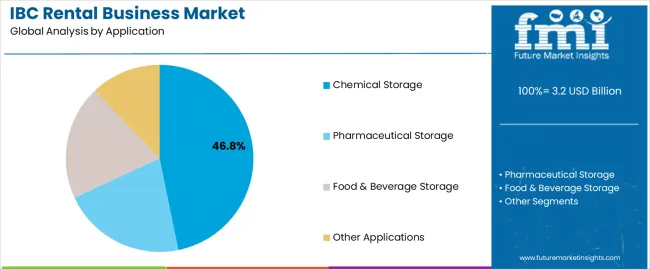
The chemical storage segment is projected to account for 46.8% of the IBC rental business market in 2025, reaffirming its position as the leading application category. Businesses and industrial facilities increasingly utilize chemical grade IBC rentals for their superior corrosion resistance characteristics, established regulatory compliance, and essential functionality in diverse chemical handling applications across multiple processing requirements. Chemical grade IBCs' standardized safety characteristics and proven reliability directly address user requirements for secure chemical storage and optimal handling value in industrial applications.
This application segment forms the foundation of modern IBC rental patterns, as it represents the format with the greatest industrial versatility and established compatibility across multiple chemical types. Business investments in safety protocols and quality standardization continue to strengthen adoption among compliance-conscious operators. With users prioritizing chemical compatibility and regulatory adherence, chemical grade IBCs align with both safety objectives and operational requirements, making them the central component of comprehensive industrial storage strategies.
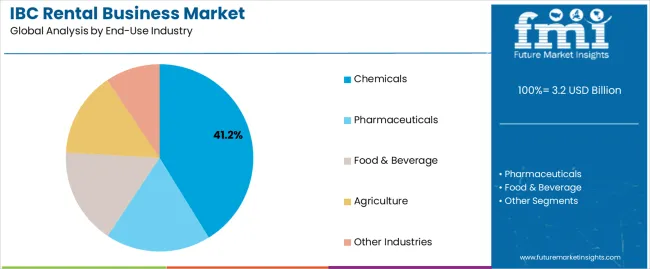
Chemical industry is projected to represent 41.2% of the IBC rental business market in 2025, underscoring its critical role as the primary sector for efficiency-focused businesses seeking superior chemical handling benefits and enhanced operational convenience credentials. Industrial users and chemical manufacturers prefer chemical industry applications for their established high-volume positioning, proven operational acceptance, and ability to maintain exceptional safety profiles while supporting diverse chemical processing during various production experiences. Positioned as essential applications for discerning operators, chemical industry offerings provide both operational efficiency excellence and cost-effective advantages.
The segment is supported by continuous improvement in IBC technology and the widespread availability of specialized cleaning options that enable regulatory compliance and premium positioning at the operational level. Rental companies are optimizing service packages to support chemical handling and accessible logistics strategies. As IBC technology continues to advance and industries seek flexible storage formats, chemical industry applications will continue to drive market growth while supporting operational efficiency and regulatory compliance strategies.
The IBC rental business market is advancing rapidly due to increasing industrial demand for capital-efficient solutions and growing need for flexible container management that emphasizes superior cost optimization outcomes across manufacturing segments and processing applications. The market faces challenges, including complexity in fleet management, maintenance requirements for specialized containers, and competitive pressures affecting premium service adoption. Innovation in digital tracking systems and automated cleaning technologies continues to influence market development and expansion patterns.
The growing adoption of IBC rental services with digital tracking capabilities is enabling businesses to develop logistics patterns that provide distinctive asset visibility benefits while commanding operational confidence and enhanced inventory reliability. Digital fleet management applications provide superior monitoring properties while allowing more sophisticated tracking features across various industrial categories. Users are increasingly recognizing the functional advantages of digital positioning for secure asset management and efficiency-conscious logistics integration.
Modern IBC rental service providers are incorporating advanced automated cleaning technologies, specialized maintenance protocols, and condition monitoring systems to enhance operational efficiency, improve asset longevity, and meet industrial demands for reduced contamination risk. These systems improve resource effectiveness while enabling new applications, including pharmaceutical-grade programs and food-safety compliant solutions. Advanced automation integration also allows providers to support lean operational positioning and efficiency objectives beyond traditional rental operations.
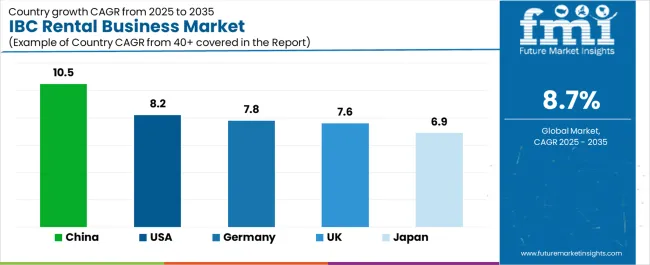
| Country | CAGR (2025-2035) |
|---|---|
| USA | 8.2% |
| Germany | 7.8% |
| UK | 7.6% |
| China | 10.5% |
| Japan | 6.9% |
The IBC rental business market is experiencing robust growth globally, with China leading at a 10.5% CAGR through 2035, driven by the expanding chemical manufacturing industry, growing industrial infrastructure development, and increasing adoption of flexible storage solutions. The USA follows at 8.2%, supported by rising chemical production demand, expanding pharmaceutical applications, and growing acceptance of rental business models. Germany shows growth at 7.8%, emphasizing established chemical industry capabilities and comprehensive logistics innovation. The UK records 7.6%, focusing on pharmaceutical applications and industrial sophistication. Japan demonstrates 6.9% growth, prioritizing quality rental solutions and technological precision.
The report covers an in-depth analysis of 40+ countries, with top-performing countries highlighted below.
Revenue from IBC rental services consumption and adoption in the USA is projected to exhibit exceptional growth with a CAGR of 8.2% through 2035, driven by the country's rapidly expanding chemical manufacturing sector, favorable industrial attitudes toward flexible asset management, and initiatives promoting innovative rental mechanisms across major industrial regions. The USA's position as a leading chemical market and increasing focus on capital-efficient operational development are creating substantial demand for high-quality IBC rental services in both commercial and specialty markets. Major chemical producers and industrial operators are establishing comprehensive rental partnerships to serve growing demand and emerging market opportunities.
Demand for IBC rental services in Germany is expanding at a CAGR of 7.8%, supported by rising chemical industry sophistication, growing processing requirements, and expanding logistics infrastructure. The country's developing technical capabilities and increasing industrial investment in precision operations are driving demand for IBC rentals across both imported and domestically operated applications. International rental companies and domestic providers are establishing comprehensive operational networks to address growing market demand for quality container services and efficient logistics solutions.
Revenue from IBC rental services in the UK is projected to grow at a CAGR of 7.6% through 2035, supported by the country's mature pharmaceutical market, established chemical culture, and leadership in regulatory compliance. Britain's sophisticated industrial base and strong support for quality assurance are creating steady demand for both traditional and innovative IBC rental varieties. Leading pharmaceutical brands and specialty manufacturers are establishing comprehensive operational strategies to serve both domestic markets and growing export opportunities.
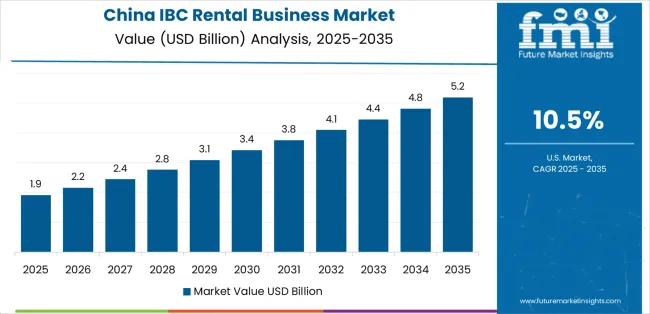
Demand for IBC rental services in China is anticipated to expand at a CAGR of 10.5% through 2035, driven by the country's emphasis on chemical industry expansion, manufacturing leadership, and sophisticated production capabilities for processes requiring specialized precision varieties. Chinese manufacturers and chemical brands consistently seek commercial-grade containers that enhance operational protection and support processing operations for both traditional and innovative industrial applications. The country's position as an Asian manufacturing leader continues to drive innovation in specialty IBC rental applications and commercial service standards.
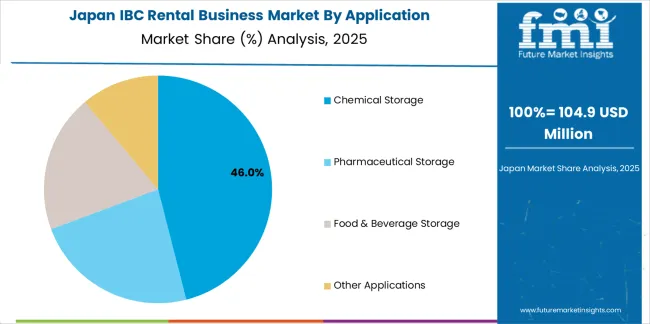
Revenue from IBC rental services in Japan is expected to grow at a CAGR of 6.9% through 2035, supported by the country's emphasis on quality manufacturing, operational precision, and advanced technology integration requiring efficient container solutions. Japanese businesses and chemical brands prioritize container reliability and operational precision, making IBC rentals essential storage for both traditional and modern processing applications. The country's comprehensive quality excellence and advancing operational patterns support continued market expansion.
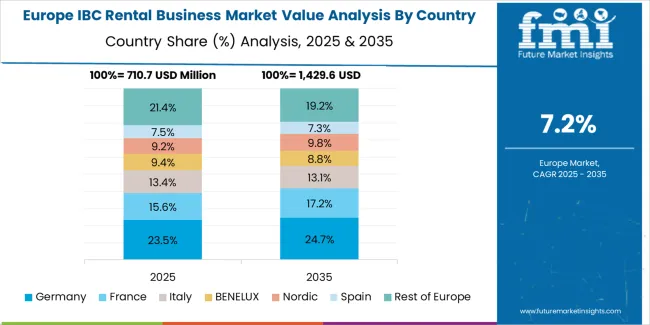
The Europe IBC rental business market is projected to grow from USD 1.1 billion in 2025 to USD 2.4 billion by 2035, recording a CAGR of 8.1% over the forecast period. Germany leads the region with a 35.2% share in 2025, moderating slightly to 34.8% by 2035, supported by its strong chemical manufacturing base and demand for premium, technically advanced rental services. The United Kingdom follows with 21.8% in 2025, easing to 21.5% by 2035, driven by a sophisticated pharmaceutical market and emphasis on regulatory compliance and operational excellence. France accounts for 16.4% in 2025, rising to 16.7% by 2035, reflecting steady adoption of premium rental solutions and chemical industry innovation. Italy holds 10.3% in 2025, expanding to 10.6% by 2035 as chemical processing innovation and specialty applications grow. Spain contributes 7.2% in 2025, growing to 7.4% by 2035, supported by expanding industrial sector and premium chemical handling. The Nordic countries rise from 5.8% in 2025 to 6.0% by 2035 on the back of strong environmental adoption and advanced logistics technologies. BENELUX declines from 3.3% in 2025 to 3.0% by 2035, reflecting market maturity and regional consolidation.
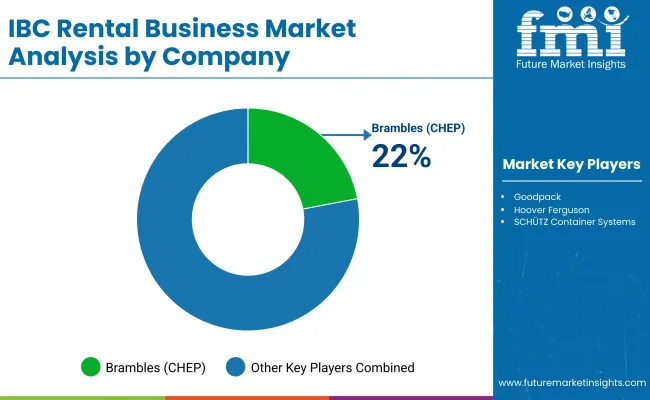
The IBC rental business market is characterized by competition among established logistics providers, specialized container rental companies, and integrated industrial service solution providers. Companies are investing in fleet management technologies, advanced cleaning system capabilities, digital tracking innovation, and comprehensive service networks to deliver consistent, high-quality, and reliable IBC rental systems. Innovation in IoT monitoring technology, automated maintenance processes, and application-specific service development is central to strengthening market position and customer satisfaction.
Mauser Packaging Solutions leads the market with a strong focus on container innovation and comprehensive rental solutions, offering commercial IBC systems with emphasis on operational excellence and technological heritage. SCHOTT AG provides specialized industrial packaging capabilities with a focus on global market applications and container engineering networks. Greif Inc. delivers integrated packaging solutions with a focus on rental positioning and operational efficiency. Time Technoplast Ltd. specializes in comprehensive industrial containers with an emphasis on regional applications. HOYER Group focuses on comprehensive logistics and container services with advanced fleet management and premium positioning capabilities.
The success of IBC rental systems in meeting industrial storage demands, cost-driven efficiency requirements, and operational integration will not only enhance chemical processing delivery outcomes but also strengthen global industrial logistics capabilities. It will consolidate emerging regions' positions as hubs for efficient container services and align advanced economies with commercial rental systems. This calls for a concerted effort by all stakeholders -- governments, industry bodies, service providers, distributors, and investors. Each can be a crucial enabler in preparing the market for its next phase of growth.
How Governments Could Spur Local Service Development and Adoption?
How Industry Bodies Could Support Market Development?
How Distributors and Industrial Players Could Strengthen the Ecosystem?
How Service Providers Could Navigate the Shift?
| Item | Value |
|---|---|
| Quantitative Units (2025) | USD 3.2 billion |
| Material Type | Stainless Steel IBCs; Plastic IBCs; Carbon Steel IBCs; Composite IBCs |
| Capacity | 500-700 liters; 700-1000 liters; 1000-1500 liters; Above 1500 liters |
| Application | Chemical Storage; Pharmaceutical Storage; Food & Beverage Storage; Other Applications |
| End-Use Industry | Chemicals; Pharmaceuticals; Food & Beverage; Agriculture; Other Industries |
| Regions | North America; Europe; Asia Pacific; Latin America; Middle East & Africa; Other Regions |
| Key Countries | United States; Germany; United Kingdom; China; Japan; and 40+ additional countries |
| Key Companies | Mauser Packaging Solutions; SCHOTT AG; Greif Inc.; Time Technoplast Ltd. (profiled); HOYER Group; Other leading IBC rental companies |
| Additional Attributes | Dollar services by material type, capacity, application & end-use; Regional demand trends; Competitive landscape; Technological advancements in fleet management; Digital tracking technology integration initiatives; Automated cleaning programs; Premium service development strategies |
The global ibc rental business market is estimated to be valued at USD 3.2 billion in 2025.
The market size for the ibc rental business market is projected to reach USD 7.4 billion by 2035.
The ibc rental business market is expected to grow at a 8.7% CAGR between 2025 and 2035.
The key product types in ibc rental business market are chemical storage, pharmaceutical storage, food & beverage storage and other applications.
In terms of end-use industry, chemicals segment to command 41.2% share in the ibc rental business market in 2025.






Full Research Suite comprises of:
Market outlook & trends analysis
Interviews & case studies
Strategic recommendations
Vendor profiles & capabilities analysis
5-year forecasts
8 regions and 60+ country-level data splits
Market segment data splits
12 months of continuous data updates
DELIVERED AS:
PDF EXCEL ONLINE
Breakdown for IBC Rental Business Market: Trends, Players, and Innovations
IBC Liner Market Size and Share Forecast Outlook 2025 to 2035
IBC Liner Market Share Insights & Industry Leaders
IBC Caps Market
FIBC Market Size and Share Forecast Outlook 2025 to 2035
FIBC Industry Analysis in Japan Size and Share Forecast Outlook 2025 to 2035
Market Share Distribution Among FIBC (Flexible Intermediate Bulk Container) Manufacturers
Metal IBC Market Forecast and Outlook 2025 to 2035
Rigid IBC Market Size and Share Forecast Outlook 2025 to 2035
Competitive Overview of Rigid IBC Market Share
Folding IBC Market Size and Share Forecast Outlook 2025 to 2035
2 Loop FIBC Bags Market Size and Share Forecast Outlook 2025 to 2035
4-Loop FIBC Market Growth - Size, Demand & Forecast 2025 to 2035
Breaking Down Market Share in 2 Loop FIBC Bags
Competitive Landscape of 4-Loop FIBC Providers
Competitive Overview of Folding Intermediate Bulk Container Companies
Aseptic IBC Market Insights & Packaging Trends 2024-2034
Composite IBCs System Market from 2025 to 2035
Ventilated FIBC Market Size, Share & Forecast 2025 to 2035
USA Folding IBC Market Analysis – Demand, Growth & Forecast 2025-2035

Thank you!
You will receive an email from our Business Development Manager. Please be sure to check your SPAM/JUNK folder too.
Chat With
MaRIA